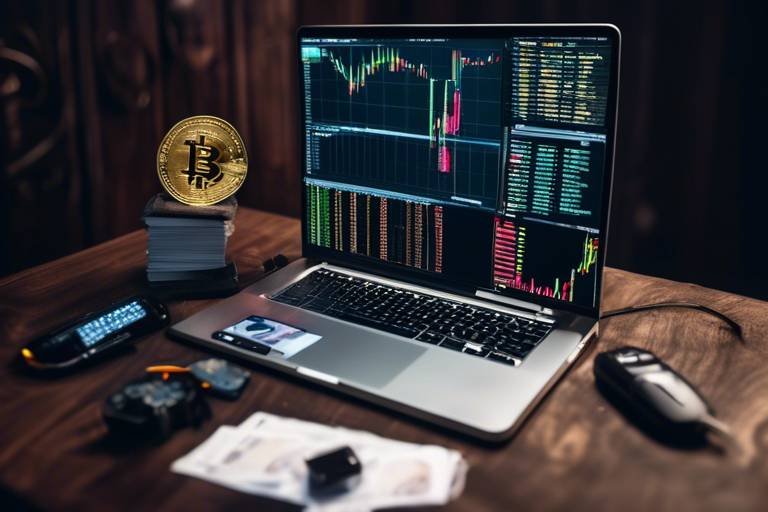Crypto Arbitrage - Profiting from Price Differences
Are you ready to dive into the thrilling world of crypto arbitrage? Imagine this: you spot a cryptocurrency trading for $100 on one exchange while it’s listed for $105 on another. What if you could buy low and sell high, pocketing that sweet $5 difference? That's the essence of crypto arbitrage! In this article, we’ll explore how savvy traders capitalize on price discrepancies across various exchanges, turning them into lucrative opportunities. This isn't just a game of chance; it's a strategic approach that, when executed correctly, can yield impressive returns.
At its core, crypto arbitrage is about identifying and exploiting price differences for the same cryptocurrency across different platforms. It’s like being a savvy shopper who knows exactly where to find the best deals! But hold on, it’s not just about finding a gap in prices; it’s about timing, strategy, and understanding the market dynamics. With the crypto market being notoriously volatile, the window for profit can close faster than you can say "blockchain." So, how do traders navigate this fast-paced environment? Let’s break it down!
First off, it’s essential to grasp the different types of arbitrage strategies available. Each strategy comes with its unique flavor and risk profile. We have spatial arbitrage, which is all about exploiting geographical price differences. Then, there’s triangular arbitrage, where traders take advantage of inefficiencies in currency pricing, all within the same exchange. Understanding these strategies is crucial for anyone looking to profit from the crypto market.
Now, let’s talk about the tools of the trade. In the world of crypto, having the right tools can make all the difference. Imagine trying to cut a steak with a butter knife—it just won’t work! Similarly, traders utilize arbitrage bots and price tracking software to automate and streamline their trading processes. These tools help traders identify opportunities in real-time, allowing them to act swiftly and decisively.
But before you jump in headfirst, it’s vital to acknowledge the risks involved. Market volatility can be a double-edged sword, swinging prices unpredictably and potentially erasing profits in the blink of an eye. Additionally, exchange delays can throw a wrench in your plans, making it essential to choose platforms known for their speed and reliability. So, while the prospect of profit is enticing, a prudent approach is necessary to navigate this exciting but risky landscape.
In conclusion, crypto arbitrage is a fascinating way to profit from the ever-evolving cryptocurrency market. With the right strategies, tools, and a keen eye for market trends, traders can turn price discrepancies into profitable ventures. Just remember, it’s not just about the chase; it’s about having a well-thought-out plan and being ready to adapt to the fast-paced world of crypto trading. Are you ready to take the plunge?
- What is crypto arbitrage? - Crypto arbitrage is the practice of buying a cryptocurrency at a lower price on one exchange and selling it at a higher price on another.
- What are the different types of crypto arbitrage? - The primary types include spatial arbitrage, triangular arbitrage, and statistical arbitrage.
- What tools can help with crypto arbitrage? - Traders often use arbitrage bots and price tracking software to identify opportunities and automate trades.
- What risks are involved in crypto arbitrage? - Risks include market volatility, exchange delays, and transaction fees that can eat into profits.

Understanding Crypto Arbitrage
Have you ever wondered how some traders seem to pull profits out of thin air? Welcome to the fascinating world of crypto arbitrage. At its core, crypto arbitrage is a trading strategy that involves buying a cryptocurrency at a lower price on one exchange and then selling it at a higher price on another. This simple yet effective method allows traders to capitalize on the price discrepancies that exist across various platforms. Imagine walking into a store where you find your favorite gadget at a discount, only to sell it at full price elsewhere—this is essentially what crypto arbitrage is all about.
The beauty of crypto arbitrage lies in its ability to leverage the inefficiencies of the market. Cryptocurrency prices can vary significantly from one exchange to another due to factors like liquidity, regional demand, and even trading volume. For instance, if Bitcoin is trading at $40,000 on Exchange A and $40,500 on Exchange B, a savvy trader can buy Bitcoin on Exchange A and sell it on Exchange B, pocketing a neat profit of $500 per Bitcoin. However, it's not just about spotting these opportunities; it requires a keen understanding of the market dynamics and swift execution.
To further illustrate this, let’s take a look at a hypothetical scenario:
| Exchange | Price of Bitcoin | Action |
|---|---|---|
| Exchange A | $40,000 | Buy |
| Exchange B | $40,500 | Sell |
In this example, the trader identifies a $500 price difference and makes a profit by executing both transactions. However, it’s crucial to remember that while the concept sounds straightforward, the execution can be quite complex. Traders must factor in transaction fees, transfer times, and market volatility—all of which can eat into profits or even turn what seems like a sure win into a loss.
Moreover, the world of crypto is incredibly fast-paced. Prices can change in a matter of seconds, meaning that a trader must be quick on their feet. Think of it like a race; the faster you are, the better your chances of success. This is why many traders utilize tools like arbitrage bots—automated systems that can execute trades at lightning speed, ensuring they don't miss out on lucrative opportunities. In essence, understanding crypto arbitrage is not just about knowing how to buy low and sell high; it's about mastering the art of timing and strategy.
In conclusion, crypto arbitrage is a thrilling way to engage with the cryptocurrency market, offering opportunities for profit that can be both exciting and rewarding. But like any investment strategy, it comes with its own set of challenges and risks. The key is to stay informed, be prepared, and act decisively to make the most out of every price discrepancy.

Types of Crypto Arbitrage
When it comes to crypto arbitrage, there’s no one-size-fits-all strategy. Traders have developed various approaches to capitalize on price discrepancies across exchanges, each with its own set of opportunities and risks. Let’s dive into the most popular types of crypto arbitrage, so you can find the one that best suits your trading style.
The first type is spatial arbitrage. This strategy involves buying a cryptocurrency on one exchange where the price is lower and selling it on another exchange where the price is higher. The key here is to leverage the price differences that arise due to geographical variances in market demand. For instance, if Bitcoin is trading at $40,000 on Exchange A and $40,500 on Exchange B, a trader can buy from A and sell on B, pocketing a neat profit. However, it’s crucial to choose exchanges wisely, considering factors like liquidity, transaction fees, and withdrawal limits to ensure that your profits aren't eaten away by costs.
Next up is triangular arbitrage, which is a bit more complex but equally rewarding. This method involves trading between three different currencies on the same exchange. Imagine you start with Bitcoin (BTC), convert it to Ethereum (ETH), and then trade ETH for Litecoin (LTC), before finally converting LTC back to BTC. If the exchange rates are favorable, you can end up with more BTC than you started with. The beauty of triangular arbitrage lies in its potential to exploit inefficiencies in currency pricing without the need to move funds between different exchanges, which can save time and reduce risks associated with transfer delays.
Another interesting approach is statistical arbitrage. This strategy relies on mathematical models and algorithms to identify price discrepancies that may not be immediately apparent. Traders using this method analyze historical price data to predict future price movements and make trades based on statistical probabilities. While this method requires a good grasp of data analysis and may not be as straightforward as spatial or triangular arbitrage, it can yield significant profits if executed correctly.
In summary, whether you’re looking to exploit geographical price differences, navigate through multiple currency pairs, or crunch numbers for statistical opportunities, there’s a type of crypto arbitrage for you. Each strategy has its own unique flavor, and understanding these differences can help you make informed decisions as you dive into the exciting world of cryptocurrency trading.
- What is crypto arbitrage? It is the practice of buying a cryptocurrency at a lower price on one exchange and selling it at a higher price on another.
- Is crypto arbitrage risky? Yes, while it can be profitable, it carries risks such as market volatility and exchange delays.
- What tools can I use for crypto arbitrage? Traders often use arbitrage bots and price tracking software to identify opportunities and automate trades.

Spatial Arbitrage
is a fascinating trading strategy that capitalizes on the price differences of the same cryptocurrency across various exchanges located in different geographical regions. Imagine if you could buy a popular digital currency like Bitcoin at a lower price in one country and sell it for a higher price in another. That’s the essence of spatial arbitrage! It’s like finding a hidden treasure in the vast ocean of crypto markets, where each exchange is a different island with its own unique pricing.
To successfully engage in spatial arbitrage, traders must first identify which exchanges offer the same cryptocurrency at varying prices. This requires a keen eye for market trends and a good understanding of the liquidity of each exchange. Liquidity refers to how easily a cryptocurrency can be bought or sold without affecting its price. High liquidity means you can execute trades quickly and at a price close to the market rate. Conversely, low liquidity can lead to slippage, where the price changes unfavorably during a trade.
Another critical factor to consider is the transaction fees associated with each exchange. These fees can eat into your profits, so it’s essential to factor them into your calculations. For instance, if you buy Bitcoin for $30,000 on Exchange A and sell it for $30,500 on Exchange B, but the transaction fees total $100, your actual profit shrinks significantly. Therefore, always ensure that the potential profit from the price discrepancy outweighs the costs involved.
Additionally, withdrawal limits can pose a challenge in spatial arbitrage. Different exchanges have different policies regarding how much cryptocurrency you can withdraw at a time. If you find an excellent arbitrage opportunity but can only withdraw a small amount, it could limit your overall profit potential. As such, it’s vital to choose exchanges that not only have favorable prices but also reasonable withdrawal limits that align with your trading goals.
Timing is another crucial element in the success of spatial arbitrage. The crypto market is notoriously volatile, with prices fluctuating rapidly. This means that the window of opportunity for executing a profitable trade can be incredibly brief. Traders need to be quick on their feet, ready to act the moment they spot a favorable price difference. Imagine trying to catch a train; if you hesitate for even a second, you might miss it. Similarly, in the world of crypto arbitrage, timing can make or break your trade.
In summary, spatial arbitrage offers an exciting way for traders to profit from price discrepancies across geographical exchanges. By understanding the dynamics of liquidity, transaction fees, withdrawal limits, and market timing, traders can navigate this landscape effectively. However, like any investment strategy, it comes with its own set of risks and challenges that must be carefully managed.
Frequently Asked Questions
- What is spatial arbitrage? It is a trading strategy that involves buying a cryptocurrency at a lower price on one exchange and selling it at a higher price on another exchange located in a different geographical region.
- How do I choose the right exchanges for spatial arbitrage? Look for exchanges with high liquidity, low transaction fees, and favorable withdrawal limits to maximize your profits.
- Why is timing important in spatial arbitrage? Because the cryptocurrency market is highly volatile, price discrepancies can change rapidly, making it crucial to act quickly to capitalize on opportunities.

Exchange Selection
Selecting the right exchanges for your crypto arbitrage strategy is akin to choosing the right tools for a craftsman; the right choice can make all the difference between success and failure. When diving into the world of crypto arbitrage, it's essential to consider several key factors that can significantly impact your profitability. One of the most critical aspects is liquidity. High liquidity means that there are enough buyers and sellers in the market, allowing you to execute trades quickly without causing significant price changes. Imagine trying to sell a rare collectible; if there are no buyers, you might have to lower your price drastically to make a sale. The same principle applies in crypto trading—if the market is illiquid, you risk missing out on profitable opportunities.
Next up is transaction fees. Every time you buy or sell a cryptocurrency, exchanges charge fees. These can vary widely from one platform to another, and if you're not careful, fees can eat into your profits faster than you can say "arbitrage." For instance, if you make a $100 profit on a trade but pay $10 in fees, your actual profit is only $90. It’s crucial to calculate these costs beforehand to ensure that your arbitrage strategy remains profitable.
Moreover, withdrawal limits can also play a significant role in your selection process. Some exchanges impose strict limits on how much cryptocurrency you can withdraw within a specific timeframe. This can be a major hindrance if you're trying to capitalize on rapid price discrepancies. Imagine you spot an opportunity to profit but can't withdraw your funds in time to make the trade; that’s a missed chance that could have translated into cold hard cash. Therefore, always check the withdrawal policies of any exchange you're considering.
In summary, the selection of exchanges is not just about finding the ones with the best prices; it's about creating a strategy that encompasses liquidity, fees, and withdrawal limits. Doing your homework in these areas can mean the difference between a well-executed arbitrage strategy and a costly mistake. By carefully evaluating these factors, you can enhance your chances of successfully capitalizing on price differences across exchanges.
- What is crypto arbitrage? Crypto arbitrage is the practice of buying a cryptocurrency at a lower price on one exchange and selling it at a higher price on another to profit from the price difference.
- Is crypto arbitrage risky? Yes, while it can be profitable, it comes with risks such as market volatility, exchange delays, and transaction fees that can eat into profits.
- How can I find arbitrage opportunities? Traders often use price tracking software and arbitrage bots to identify price discrepancies across different exchanges in real-time.

Market Timing
When it comes to crypto arbitrage, timing is everything. Imagine you’re at a bustling market, and you spot a rare item being sold for a steal. If you hesitate, someone else might snatch it up before you can make your move. The same principle applies to crypto trading. Price discrepancies between exchanges can vanish in the blink of an eye, making it essential for traders to act swiftly.
To successfully capitalize on these fleeting opportunities, traders need to stay alert and be ready to execute trades at a moment's notice. This means keeping an eye on the market trends and understanding the volatility that often accompanies cryptocurrencies. For example, if you notice that Bitcoin is trading lower on Exchange A compared to Exchange B, you need to be prepared to buy on Exchange A and sell on Exchange B as quickly as possible. However, if you delay, you might find that the price has already adjusted, and your potential profit has evaporated.
In addition to being quick, traders should also consider the time of day when engaging in arbitrage. Different exchanges may experience varying levels of activity based on geographical location and trading hours. For instance, while the Asian markets may be bustling, the European exchanges could be quieter, leading to unique price movements. Understanding these patterns can help traders identify the best times to execute their strategies.
Moreover, using real-time data tracking can significantly enhance a trader's ability to make informed decisions. Many traders rely on advanced tools and software that provide up-to-the-minute price alerts across multiple exchanges. This technology allows them to react instantly to price changes, ensuring they don’t miss out on profitable trades. Here’s a quick look at some essential factors to consider for effective market timing:
| Factor | Importance |
|---|---|
| Market Volatility | High - Can impact price discrepancies. |
| Exchange Activity | Medium - Varies by time zone and trading hours. |
| Real-Time Data Tools | High - Essential for quick decision-making. |
In conclusion, effective market timing is a crucial element of successful crypto arbitrage. By staying informed, using the right tools, and acting quickly, traders can significantly increase their chances of profiting from price differences. Just remember, in the world of crypto, the early bird truly does catch the worm!
- What is crypto arbitrage? - Crypto arbitrage is a trading strategy that involves buying a cryptocurrency at a lower price on one exchange and selling it at a higher price on another.
- What are the risks associated with crypto arbitrage? - Risks include market volatility, exchange delays, and transaction fees that can affect profit margins.
- How can I identify arbitrage opportunities? - Using price tracking software and arbitrage bots can help you identify and act on price discrepancies quickly.

Triangular Arbitrage
Triangular arbitrage is one of the most fascinating concepts in the world of cryptocurrency trading. It involves a series of trades that capitalize on discrepancies in currency prices within a single exchange. Imagine you have three different currencies: A, B, and C. The idea is to convert currency A to currency B, then currency B to currency C, and finally currency C back to currency A. If the exchange rates are favorable, you end up with more of currency A than you started with. It's like a financial magic trick, where you exploit inefficiencies in the market to pull off a profit!
To illustrate this concept further, let’s say you have Bitcoin (BTC), Ethereum (ETH), and Litecoin (LTC). You notice that the exchange rates allow you to trade BTC for ETH, then ETH for LTC, and finally LTC back to BTC, resulting in a net gain. It’s essential to act swiftly because these opportunities can vanish in the blink of an eye, much like a fleeting mirage in the desert. The key here is to keep a keen eye on the market and be ready to execute trades quickly.
The beauty of triangular arbitrage lies in its simplicity and the fact that it can be executed on a single exchange, reducing the risks associated with transferring funds between different platforms. However, it’s not without its challenges. Traders must be aware of the transaction fees and market slippage, which can eat into potential profits. Here’s a breakdown of what you should consider:
- Transaction Fees: Every trade incurs a fee. If your profit margin is slim, these fees can turn a winning trade into a losing one.
- Market Slippage: This occurs when the price of a cryptocurrency changes between the time you place an order and when it gets executed, potentially reducing your profits.
- Execution Speed: The faster you can execute your trades, the better your chances of capitalizing on price discrepancies.
In addition to understanding the mechanics of triangular arbitrage, traders should also utilize various tools to enhance their trading strategies. Automated trading bots can help execute trades at lightning speed, ensuring that you don’t miss out on opportunities. Additionally, price tracking software can provide real-time updates on currency prices, allowing you to make informed decisions on the fly.
Ultimately, triangular arbitrage can be a highly effective strategy for those willing to invest the time and resources into understanding the market dynamics. It’s a game of strategy, timing, and precision – much like a chess match where every move counts. By mastering this technique, traders can navigate the often volatile waters of cryptocurrency trading with greater confidence and success.
If you’re new to triangular arbitrage or crypto trading in general, you might have some questions. Here are a few frequently asked questions that can help clarify this intriguing trading strategy.
- What is triangular arbitrage? Triangular arbitrage is a trading strategy that involves converting one currency into another and then back into the original currency to exploit price discrepancies.
- Is triangular arbitrage profitable? Yes, it can be profitable if executed correctly, but it requires quick execution and careful consideration of fees and market conditions.
- Do I need special tools for triangular arbitrage? While not mandatory, using trading bots and price tracking software can significantly enhance your ability to identify and act on arbitrage opportunities quickly.

Risks of Crypto Arbitrage
While crypto arbitrage can be an enticing way to profit from price discrepancies, it is not without its risks. Just like any investment strategy, understanding these risks can be the difference between success and failure. One of the most significant risks is market volatility. The cryptocurrency market is notorious for its rapid price fluctuations, which can occur within seconds. Imagine spotting a price difference where you could buy low and sell high, only to find that by the time you execute the trade, the prices have equalized, leaving you with no profit or, worse, a loss. This scenario is all too common in the fast-paced world of crypto trading.
Another critical risk is exchange delays. When you engage in arbitrage, timing is everything. If there is a lag in order execution or if the transfer times between exchanges are slower than expected, you could miss out on a profitable opportunity. For instance, if you place an order on one exchange and the price changes before the transaction is completed, your anticipated profit could vanish. Therefore, selecting exchanges with fast processing times is essential to mitigate this risk.
Additionally, transaction fees can eat into your profits. Each time you buy or sell a cryptocurrency, you incur fees that can vary significantly from one exchange to another. If these fees are too high, they can negate any potential gains from arbitrage. Traders need to factor in these costs when calculating potential profits. It’s wise to do a quick comparison of fees across different platforms before committing to a transaction.
Moreover, the liquidity of the exchanges plays a crucial role in the success of arbitrage strategies. If an exchange lacks sufficient liquidity, it may be challenging to execute trades at the desired price. This could lead to slippage, where the actual execution price differs from the expected price, potentially resulting in losses. Thus, ensuring that you are trading on platforms with high liquidity is vital for effective arbitrage.
Lastly, there are regulatory risks to consider. The cryptocurrency landscape is constantly evolving, with regulations varying by country and even by state. A sudden regulatory change can impact exchange operations, affecting your ability to trade or withdraw funds. Staying informed about the regulatory environment in your jurisdiction is essential for any trader.
In summary, while crypto arbitrage offers exciting opportunities, it is crucial to be aware of the associated risks. By understanding factors such as market volatility, exchange delays, transaction fees, liquidity, and regulatory issues, traders can make more informed decisions and increase their chances of success in the world of cryptocurrency trading.
- What is crypto arbitrage?
Crypto arbitrage is the practice of buying a cryptocurrency at a lower price on one exchange and selling it at a higher price on another to profit from the price difference.
- Is crypto arbitrage safe?
While it can be profitable, crypto arbitrage carries risks such as market volatility, exchange delays, and transaction fees that traders should consider.
- How do I choose the right exchanges for arbitrage?
Look for exchanges with high liquidity, low transaction fees, and quick processing times to maximize your chances of success.
- Can I automate my arbitrage trades?
Yes, using arbitrage bots can help automate your trades and execute them at optimal times without manual intervention.

Market Volatility
Market volatility is a critical factor that every crypto arbitrage trader must consider. It refers to the degree of variation in the price of cryptocurrencies over time. In the fast-paced world of crypto trading, prices can swing dramatically within minutes, which can either create golden opportunities or lead to devastating losses. Imagine you're trying to catch a wave while surfing; if you time it right, you ride high, but if you hesitate, you wipe out. This is precisely how volatility works in the crypto market.
When engaging in crypto arbitrage, traders often rely on the assumption that price discrepancies between exchanges will remain stable long enough for them to execute their trades. However, this assumption can be dangerously misleading. The market is influenced by a myriad of factors, including news events, regulatory changes, and even social media trends. Each of these elements can cause sudden price shifts that may vanish the arbitrage opportunity before a trader can act. For instance, a tweet from a prominent figure can send prices soaring or crashing, making it crucial for traders to stay alert and ready to respond.
Moreover, it’s not just the immediate price changes that traders need to worry about. The overall market sentiment can also affect volatility. If traders believe that a particular cryptocurrency is about to rise, they may rush to buy it, driving the price up and erasing any potential profit from arbitrage. Conversely, if fear grips the market, prices can plummet, leaving traders with losses instead of gains. Thus, understanding market sentiment is just as important as monitoring price movements.
To illustrate the impact of market volatility on crypto arbitrage, consider the following table that outlines potential scenarios:
| Scenario | Price Difference | Potential Profit | Impact of Volatility |
|---|---|---|---|
| Stable Market | $100 on Exchange A, $110 on Exchange B | $10 | Low risk of losing profit |
| High Volatility | $100 on Exchange A, $120 on Exchange B | $20 (potential) | High risk; price may change before trade execution |
| Market Crash | $100 on Exchange A, $90 on Exchange B | -$10 (loss) | Immediate losses due to rapid price drop |
In conclusion, while market volatility can present lucrative opportunities for crypto arbitrage, it also poses significant risks. Traders must be vigilant and equipped with the right tools to monitor price changes and market sentiment. The ability to react swiftly to market fluctuations can mean the difference between a profitable trade and a costly mistake.
- What is crypto arbitrage? Crypto arbitrage is the practice of buying a cryptocurrency at a lower price on one exchange and selling it at a higher price on another.
- Is crypto arbitrage risky? Yes, while it can be profitable, it comes with risks such as market volatility and exchange delays.
- What tools can help with crypto arbitrage? Tools like arbitrage bots and price tracking software can assist traders in identifying opportunities and executing trades efficiently.

Exchange Delays
When diving into the world of crypto arbitrage, one of the most significant hurdles traders face is . Imagine you spot a golden opportunity to buy Bitcoin at a lower price on one exchange and sell it for a higher price on another. Sounds easy, right? But hold on! If there's a delay in executing your order or transferring your funds between exchanges, that golden opportunity can vanish in the blink of an eye.
Exchange delays can occur for several reasons, including:
- Network Congestion: When too many transactions are happening simultaneously, exchanges may struggle to process orders quickly.
- Technical Issues: Sometimes, the exchange's platform may experience glitches or downtime, which can lead to delays in executing trades.
- Withdrawal Limits: Many exchanges impose limits on how much cryptocurrency you can withdraw at one time, which can slow down the arbitrage process.
To mitigate the risks associated with exchange delays, traders should consider a few strategies:
- Choose Reputable Exchanges: Opt for exchanges known for their reliability and fast processing times. Research user reviews and performance metrics before committing.
- Utilize Multiple Accounts: Having accounts on several exchanges can help you quickly execute trades, reducing the impact of delays on any single platform.
- Stay Informed: Keeping an eye on the market and being aware of any ongoing issues with your chosen exchanges can help you anticipate delays.
In essence, while exchange delays can throw a wrench in your arbitrage plans, being proactive and strategic can help you navigate these challenges effectively. Remember, in the fast-paced world of crypto trading, timing is everything, and even a few seconds can mean the difference between profit and loss.
Q1: What is crypto arbitrage?
A1: Crypto arbitrage is the practice of buying a cryptocurrency at a lower price on one exchange and selling it at a higher price on another, taking advantage of price differences to make a profit.
Q2: What are the risks associated with crypto arbitrage?
A2: The risks include market volatility, exchange delays, and transaction fees that can eat into your profits.
Q3: How can I minimize risks in crypto arbitrage?
A3: You can minimize risks by choosing reliable exchanges, using automated trading tools like arbitrage bots, and staying informed about market conditions.
Q4: Are there tools to help with crypto arbitrage?
A4: Yes, there are various tools available, such as arbitrage bots and price tracking software, that can help traders identify opportunities and execute trades effectively.

Tools for Crypto Arbitrage
This article explores the concept of crypto arbitrage, its various strategies, and how traders can capitalize on price discrepancies across different exchanges for profit.
Crypto arbitrage involves buying a cryptocurrency at a lower price on one exchange and selling it at a higher price on another, capitalizing on price differences to generate profit.
There are several types of crypto arbitrage strategies, including spatial arbitrage, triangular arbitrage, and statistical arbitrage, each offering unique opportunities and risks for traders.
Spatial arbitrage refers to the practice of exploiting price differences for the same cryptocurrency across different geographical exchanges, allowing traders to profit from regional market variances.
Choosing the right exchanges for spatial arbitrage is crucial; traders must consider liquidity, transaction fees, and withdrawal limits to maximize their profits effectively.
Timing plays a vital role in spatial arbitrage success, as price discrepancies can fluctuate rapidly. Traders must act quickly to capitalize on these opportunities.
Triangular arbitrage involves trading between three different currencies on the same exchange to exploit inefficiencies in currency pricing, offering a unique approach to profit generation.
While crypto arbitrage can be profitable, it also comes with inherent risks, including market volatility, exchange delays, and potential losses from transaction fees.
Market volatility can significantly impact arbitrage opportunities, as rapid price changes may eliminate potential profits or lead to unexpected losses during trades.
Delays in order execution or transfer times between exchanges can hinder arbitrage strategies, making it essential for traders to choose platforms with fast processing times.
In the fast-paced world of crypto trading, having the right tools can make all the difference. not only help traders identify lucrative opportunities but also streamline the trading process, ensuring efficiency and effectiveness. One of the most popular tools among traders is the arbitrage bot. These automated trading systems are designed to execute trades at optimal times, allowing traders to take advantage of price discrepancies without the need for constant monitoring. Imagine having a tireless assistant who works around the clock to find the best deals for you!
Another crucial tool is price tracking software. This software enables traders to monitor cryptocurrency prices across multiple exchanges in real-time. By providing instant notifications about price changes, it empowers traders to act swiftly. For instance, if Bitcoin is trading at $30,000 on Exchange A and $30,500 on Exchange B, the price tracking software alerts the trader, allowing them to execute a profitable trade before the opportunity disappears.
Moreover, many traders utilize portfolio management tools to keep track of their investments and performance. These tools can analyze your trades and provide insights into your trading patterns, helping you refine your strategies over time. It's like having a personal coach who guides you through your trading journey!
Here's a quick overview of some essential tools for crypto arbitrage:
| Tool | Description |
|---|---|
| Arbitrage Bots | Automated systems that execute trades based on predefined criteria to capitalize on price differences. |
| Price Tracking Software | Real-time monitoring tools that alert traders to price changes across multiple exchanges. |
| Portfolio Management Tools | Tools that help traders analyze their trades and track investment performance. |
In conclusion, leveraging these tools can significantly enhance a trader's ability to capitalize on arbitrage opportunities. However, it's essential to remain vigilant and continuously adapt to the ever-changing crypto landscape.
- What is crypto arbitrage? - Crypto arbitrage is the practice of buying a cryptocurrency at a lower price on one exchange and selling it at a higher price on another.
- Is crypto arbitrage risky? - Yes, while it can be profitable, it comes with risks such as market volatility and exchange delays.
- What tools do I need for crypto arbitrage? - Essential tools include arbitrage bots, price tracking software, and portfolio management tools.

Arbitrage Bots
In the fast-paced world of cryptocurrency trading, have become indispensable tools for traders looking to capitalize on fleeting price discrepancies. These automated systems are designed to execute trades at lightning speed, allowing users to take advantage of opportunities that manual trading simply cannot match. Imagine having a tireless assistant who never sleeps, always on the lookout for the best prices across various exchanges—that’s essentially what an arbitrage bot does!
One of the most appealing aspects of using arbitrage bots is their ability to eliminate human emotion from trading decisions. Emotions like fear and greed can cloud judgment and lead to missed opportunities or poor decisions. Bots operate purely on pre-set algorithms, executing trades based on data and market conditions without the influence of human feelings. This can be particularly beneficial in the volatile crypto market, where prices can swing dramatically in mere seconds.
However, not all arbitrage bots are created equal. When choosing a bot, traders should consider several factors:
- Performance: Look for bots that have a proven track record of profitability.
- Customization: The ability to adjust parameters and strategies is crucial for adapting to market changes.
- Security: Ensure that the bot adheres to stringent security protocols to protect your funds and data.
Many arbitrage bots come with user-friendly interfaces, making them accessible even to those who may not be tech-savvy. Some bots offer features like backtesting, which allows traders to simulate how a strategy would have performed in the past. This can provide valuable insights and help traders refine their approaches before committing real capital.
Despite their advantages, it’s essential to remember that using arbitrage bots is not without its challenges. For instance, the effectiveness of these bots can be hindered by exchange limitations, such as withdrawal fees, trading limits, and delays in order execution. Therefore, traders must conduct thorough research and select the right exchanges to pair with their bots for optimal performance.
In conclusion, arbitrage bots can be a game-changer for traders seeking to exploit price differences across cryptocurrency exchanges. By automating the trading process, these bots not only save time but also enhance the potential for profits. However, like any trading strategy, they require careful planning and ongoing management to ensure success.
- What is an arbitrage bot? An arbitrage bot is an automated trading system that executes trades based on predefined algorithms to capitalize on price discrepancies across different exchanges.
- Are arbitrage bots safe to use? While many bots are secure, it's crucial to choose reputable ones and ensure they follow strong security protocols to protect your funds.
- Can I use arbitrage bots if I'm a beginner? Yes! Many arbitrage bots are designed with user-friendly interfaces and offer educational resources to help beginners get started.
- How do I choose the right arbitrage bot? Look for bots with a proven track record, customization options, and strong security measures.

Price Tracking Software
In the fast-paced world of cryptocurrency trading, having the right tools at your disposal can mean the difference between making a profit and missing out on lucrative opportunities. is one such essential tool that every crypto trader should consider. These applications are designed to monitor cryptocurrency prices across multiple exchanges in real-time, allowing traders to stay updated on the latest market movements. Imagine trying to catch a falling knife; without the right tools, you might just end up with a cut!
With price tracking software, you gain the ability to quickly identify price discrepancies between exchanges, which is crucial for executing successful arbitrage trades. The software typically provides a user-friendly interface that displays current prices, historical data, and even alerts for significant price changes. This means that you won’t have to constantly refresh multiple exchange websites, wasting precious time that could be spent making trades. Instead, you can focus on analyzing data and making informed decisions.
Many price tracking tools also come equipped with features such as customizable alerts, which notify you when a cryptocurrency reaches a certain price point or when a significant price difference arises between exchanges. This proactive approach can help you seize opportunities before they vanish into thin air. Here’s a brief overview of some popular price tracking software options:
| Software Name | Key Features | Platforms Supported |
|---|---|---|
| CoinMarketCap | Real-time price tracking, historical data, news updates | Web, iOS, Android |
| CryptoCompare | Portfolio management, price alerts, exchange comparisons | Web, iOS, Android |
| Blockfolio | Portfolio tracking, news aggregation, price alerts | iOS, Android |
Each of these tools brings something unique to the table, so it’s wise to explore them and find the one that best fits your trading style. Remember, in the world of crypto arbitrage, timing is everything. If you can get a heads-up on a price drop or a spike, you’ll be in a much better position to make profitable trades.
Moreover, as you delve deeper into the realm of price tracking software, consider integrating it with other trading tools such as arbitrage bots. This combination can create a powerful trading ecosystem where you can automate trades based on the alerts generated by the price tracking software. Essentially, you’ll be setting yourself up for success by letting technology do the heavy lifting while you focus on strategy and market analysis.
- What is crypto arbitrage? Crypto arbitrage is the practice of buying a cryptocurrency at a lower price on one exchange and selling it at a higher price on another.
- How does price tracking software work? Price tracking software monitors cryptocurrency prices across multiple exchanges in real-time, alerting users to price discrepancies and market changes.
- Can I automate my trading using price tracking software? Yes, many price tracking tools can be integrated with trading bots to automate trades based on specific price alerts.
- What are the risks of crypto arbitrage? Risks include market volatility, exchange delays, and transaction fees, which can impact potential profits.
Frequently Asked Questions
- What is crypto arbitrage?
Crypto arbitrage is the practice of buying a cryptocurrency at a lower price on one exchange and selling it at a higher price on another. This strategy allows traders to capitalize on price discrepancies across different platforms, potentially generating profits from the differences.
- What are the different types of crypto arbitrage?
There are several types of crypto arbitrage strategies, including spatial arbitrage, triangular arbitrage, and statistical arbitrage. Each type offers unique opportunities and risks, depending on how traders choose to exploit price differences in the market.
- How does spatial arbitrage work?
Spatial arbitrage involves taking advantage of price differences for the same cryptocurrency across various geographical exchanges. Traders can profit from regional market variances by buying low in one location and selling high in another.
- What should I consider when selecting exchanges for arbitrage?
When choosing exchanges for spatial arbitrage, it's crucial to consider factors such as liquidity, transaction fees, and withdrawal limits. These elements can significantly impact your overall profitability and determine the success of your trading strategy.
- What risks are associated with crypto arbitrage?
While crypto arbitrage can be profitable, it comes with inherent risks, including market volatility, exchange delays, and potential losses from transaction fees. Traders need to be aware of these risks to manage their strategies effectively.
- How can market volatility affect my arbitrage opportunities?
Market volatility can significantly impact arbitrage opportunities, as rapid price changes may eliminate potential profits or lead to unexpected losses during trades. Staying alert and acting quickly is essential to mitigate these risks.
- What tools can help with crypto arbitrage?
Various tools and software can assist traders in identifying arbitrage opportunities, automating trades, and managing risks. Popular options include arbitrage bots and price tracking software, which enhance overall trading effectiveness.
- What are arbitrage bots?
Arbitrage bots are automated trading systems designed to execute trades at optimal times. They allow traders to take advantage of price discrepancies without manual intervention, making the trading process more efficient.
- How does price tracking software work?
Price tracking software helps traders monitor cryptocurrency prices across multiple exchanges in real-time. By providing quick access to price data, it enables traders to identify potential arbitrage opportunities rapidly.



















